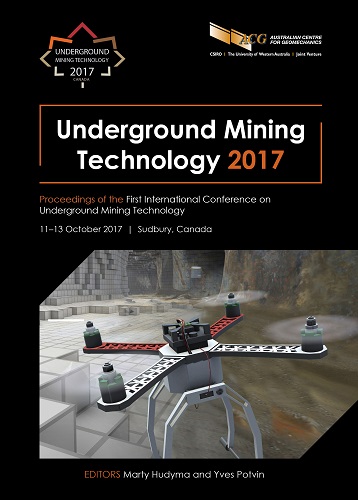Energy consumption analysis of battery electric vehicles in underground environments

|
Authors: Kukkonen, S |
DOI https://doi.org/10.36487/ACG_rep/1710_46_Kukkonen
Cite As:
Kukkonen, S 2017, 'Energy consumption analysis of battery electric vehicles in underground environments', in M Hudyma & Y Potvin (eds), UMT 2017: Proceedings of the First International Conference on Underground Mining Technology, Australian Centre for Geomechanics, Perth, pp. 569-580, https://doi.org/10.36487/ACG_rep/1710_46_Kukkonen
Abstract:
Battery electric vehicles (BEVs) have many benefits over conventional diesel powered vehicles such as higher energy efficiency, no local emissions, reduced need for ventilation, lower operating costs, less maintenance need and higher performance. On the other hand, BEVs have a shorter operating range than diesel vehicles. In order to realise all benefits, mining operation and design need to be adapted to the requirements of BEVs. One approach is to carry out energy consumption analysis of different vehicles and to optimise mining processes using such information. In this paper, the BEV energy consumption of driving and processes are analysed. Processes such as explosives charging, concrete spraying and logistics are discussed. The resulting energy consumption information is then used to discuss any adaptation requirements to operational mining and design. This includes topics like how to design battery charging infrastructure for uninterrupted operation and prospects of battery operated processes and operational expense savings.
Keywords: battery electric vehicles, fully electric, batteries, energy consumption
References:
Battery University 2017, Is Li-Ion the Solution for the Electric Vehicle?, Cadex Electronics Inc., Richmond, viewed 27 March 2017,
Global Mining Standards and Guidelines Group (GMSG) 2017, Electric Mine Project, Mining Standards and Guideline Committee, Montreal, viewed 27 March 2017,
Halmeaho, T 2016, Electric bus R&D platform – results from commercial electric buses, presented at the Electric Commercial Vehicles Final Seminar, 11–12 May 2016, VTT Technical Research Centre of Finland Ltd, Espoo, viewed 27 March 2017,
Jacobs, W, Hodkiewicz, MR & Bräunl, T 2014, ‘A cost–benefit analysis of electric loaders to reduce diesel emissions in underground hard rock mines’, IEEE Transactions on Industry Applications, vol. 51, no. 3, pp. 2565–2573.
Kukkonen, S 2014, Current Trends in Battery Technology, presented at the Electric Commercial Vehicles National Seminar,
11–12 May 2016, Helsinki, VTT Technical Research Centre of Finland Ltd, Espoo, viewed 27 March 2017,
Landry, A 2016, New Mine Development Considerations, Diesel Versus Electric Operation of Equipment, presented at the 22nd Annual MDEC Conference (MDEC 2016), 4–6 October 2016, Toronto, Mining Diesel Emissions Council, Kanata, viewed 23 June 2017,
Paraszczak, J, Laflamme, M & Fytas, K 2013, ‘Electric load-haul-dump machines: real alternative for diesels?’, CIM Journal, vol. 4, no. 1.
Peters, S, de Klerk, N, Reid, A, Fritschi, L, Musk, AW & Vermeulen, R 2016, ‘Estimation of quantitative levels of diesel exhaust exposure and the health impact in the contemporary Australian mining industry’, Occupational & Environmental Medicine, vol. 74, no. 4, pp. 282–289.
Rahkola, P 2016, Electric City Bus Energy Flow Model, presented at the Electric Commercial Vehicles Final Seminar, VTT Technical Research Centre of Finland Ltd, Espoo, viewed 27 March 2017,
Silverman, DT, Samanic, CM, Lubin, JH, Blair, AE, Stewart, PA, Vermeulen, R & Attfield, MD 2012, ‘The diesel exhaust in miners study: A nested case–control study of lung cancer and diesel exhaust’, Journal of the National Cancer Institute, vol. 104, no. 11, pp. 855–868.
The Charging Interface Initiative e.V. 2017, What is the Combined Charging System (CCS)?, CharIN e.V, Berlin, viewed 27 March 2017,
© Copyright 2025, Australian Centre for Geomechanics (ACG), The University of Western Australia. All rights reserved.
View copyright/legal information
Please direct any queries or error reports to repository-acg@uwa.edu.au
View copyright/legal information
Please direct any queries or error reports to repository-acg@uwa.edu.au